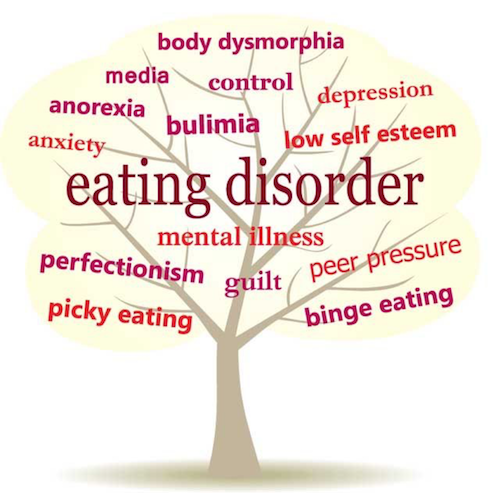Eating Disorders: Harming the Body and Mind
By Quinn Fahey
“I would love to lose just five pounds!” Does this sound familiar? For thousands of men and women throughout the world, bodybuilders and gym junkies included, this wish has led to much more than losing a bit of weight. It has caused individuals to obsess over body fat, dieting, and body image as a measure of worth. According to the National Association of Anorexia Nervosa and Associated Disorders (ANAD), nearly 30 million people of all ages and genders suffer from an eating disorder. Of these 30 million people, all are daughters, sons, friends, fathers, and mothers. Five-year-old tikes constantly asking for snacks even after eating a large meal may be a sign of an onset eating disorder. Likewise, an immobile 82-year-old refusing to eat for fear of weight gain is at risk for an eating disorder. What makes this even more shocking is that one of these individuals dies every 62 minutes as a direct result from an eating disorder. From decades of being harassed for “weird” eating patterns such as hiding food or cutting it into extremely small pieces, those suffering with an eating disorder are beginning to be diagnosed. Many cases are appearing in psychological studies, discussions, and books. The growing awareness means that new therapeutic options are beginning to emerge. One such therapy is Basic Body Awareness Therapy, which competes against the standard treatment of hospitalization.
The National Eating Disorder Association (NEDA) has done its best with limited funding to provide some relief to individuals with eating disorders. A minimum number of treatment options exist for all eating disorders no matter how severe. Current treatment includes seeing a special doctor daily, hospitalization, and psychotherapy—a therapy designed for helping with mental health problems.
While we do our best to give sympathy for people with an eating disorder, it is difficult to understand the pain, depression, and terror each person is going through when entering an unknown environment such as a hospital. It is often forgotten that they are mentally ill in the same way human beings with depression, bipolar disorder, and schizophrenia are. We give support and sympathy for physical or emotional disorders while punishing individuals for the way they eat. This unfair treatment teaches individuals, especially young children, that it is okay to be depressed but not to starve yourself.
Whether it be physical pain from falling onto hot asphalt on a July afternoon, or mental, feeling discouraged from failing an important test, people typically learn to adapt in a healthy manner. Yet, what happens when usual coping mechanisms no longer help? How is someone supposed to heal if he is unsure about the cause of the disease? This is a common worry for sufferers of eating disorders that is not discussed in current therapies. Body Awareness Therapy, though, eases the fear and dives into the reason behind disturbed body image present in the majority of people with an eating disorder. The therapy was based off of French psychoanalyst Dropsy and brought into a clinical setting by Scandinavian physiotherapist Gertrude Roxandel (Catlan-Matamoros, et. al 2010, 618).
Although the therapy has not been used as much as the more popular treatments, it has been practiced in health centers and rehabilitation settings. It combines working on proper posture, breathing exercises, and mental awareness. Though relatively new, Body Awareness Therapy carries a substantial number of eating disorder patients to health. A study recently found that out of 28 patients willing to participate in Body Awareness Therapy (both individually and in a group setting) for seven weeks, decreased their score from a 32 to a 36 out of 40 on an Eating Attitudes test (see references). The Eating Attitudes test is a questionnaire describing certain eating behaviors and is typically used when diagnosing eating disorders. Decreasing in score is a major milestone for anyone under the iron fist of an eating disorder. It gives a light to the end of a dark, dark tunnel. Despite its relatively new presence in treatment options, Body Awareness Therapy has the potential to give freedom and control back to people trapped inside their own mind.
References
Catalan-Matamoros, Daniel, et al. A pilot study on the effect of Basic Body Awareness Therapy in patients with eating disorders: a randomized controlled trial. Clinical Rehabilitation 25.7 (2011). 618-620.
Eating Disorder Statistics: National Association of Anorexia Nervosa and Associated Disorders. National Association of Anorexia Nervosa and Associated Disorders.

